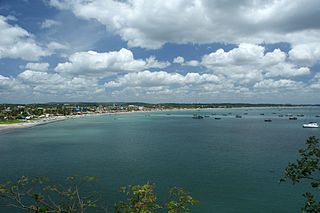
Trincomalee, historically known as Gokanna and Gokarna, is the administrative headquarters of the Trincomalee District and major resort port city of Eastern Province, Sri Lanka. Located on the east coast of the island overlooking the Trincomalee Harbour, Trincomalee has been one of the main centres of Sri Lankan Tamil speaking culture on the island for nearly a millennium. With a population of 99,135, the city is built on a peninsula of the same name, which divides its inner and outer harbours. It is home to the famous Koneswaram temple from where it developed and earned its historic Tamil name Thirukonamalai. The town is home to other historical monuments such as the Bhadrakali Amman Temple, Trincomalee, the Trincomalee Hindu Cultural Hall and, opened in 1897, the Trincomalee Hindu College. Trincomalee is also the site of the Trincomalee railway station and an ancient ferry service to Jaffna and the south side of the harbour at Muttur.

Dhobi known in some places as Dhoba, Rajaka, a Scheduled caste in India and the greater Indian subcontinent whose traditional occupations are washing, ironing, and agricultural labour.

Batticaloa is a major city in the Eastern Province, Sri Lanka, and its former capital. It is the administrative capital of the Batticaloa District. The city is the seat of the Eastern University of Sri Lanka and is a major commercial centre. It is on the east coast, 111 kilometres (69 mi) south of Trincomalee, and is situated on an island. Pasikudah is a popular tourist destination situated 35 km (22 mi) northwest with beaches and flat year-round warm-water shallow-lagoons.

Joseph Pararajasingham was a Sri Lankan Tamil civil servant, journalist, businessman and politician. He was Member of Parliament for Batticaloa District from 1990 to 2004 and a National List Member of Parliament from 2004 to 2005. A member of the Tamil National Alliance, he was shot dead on Christmas Day 2005 as he attended midnight mass at St. Mary's Cathedral, Batticaloa.

Koneswaram Temple of Trincomalee or Thirukonamalai Konesar Temple – The Temple of the Thousand Pillars and Dakshina-Then Kailasam is a classical-medieval Hindu temple complex in Trincomalee, a Hindu religious pilgrimage centre in Eastern Province, Sri Lanka. The most sacred of the Pancha Ishwarams of Sri Lanka, it was built significantly during the ancient period on top of Konesar Malai, a promontory overlooking Trincomalee District, Gokarna bay and the Indian Ocean. The monument contains its main shrine to Shiva in the form Kona-Ishvara, shortened to Konesar.
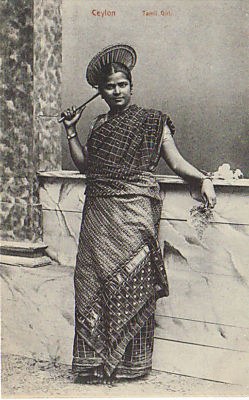
Sri Lankan Tamils, also known as Ceylon Tamils or Eelam Tamils, are Tamils native to the South Asian island state of Sri Lanka. Today, they constitute a majority in the Northern Province, form the plurality in the Eastern Province and are in the minority throughout the rest of the country. 70% of Sri Lankan Tamils in Sri Lanka live in the Northern and Eastern provinces.
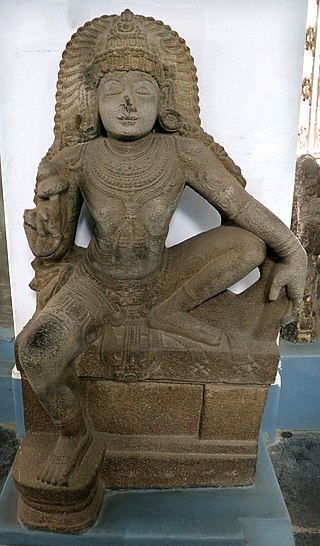
Aiyanar is a Dravidian god venerated in South India and Sri Lanka. His worship is prevalent amongst Tamil people. Some studies suggest that Ayyanar may have also been worshipped in Southeast Asian countries in the past. He is primarily worshipped as one of the gods of Tamil Nadu. Temples to Aiyanar are usually flanked by gigantic colourful statues of him and his companions riding horses or elephants.

The Sri Lankan Tamil dialects or Ceylon Tamil or commonly in Tamil language Eelam Tamil are a group of Tamil dialects used in Sri Lanka by its native Tamil speakers that is distinct from the dialects of Tamil spoken in Tamil Nadu. It is broadly categorized into three sub groups: Jaffna Tamil, Batticaloa Tamil, and Negombo Tamil dialects. But there are a number of sub dialects within these broad regional dialects as well. These dialects are also used by ethnic groups other than Tamils and Muslims such as Sinhalese people, Portuguese Burghers and the indigenous Coastal Vedda people.
Village deities are a common feature of the Hindu pantheon of deities. They are known as Gramadevatas. Each Hindu region and caste of India and South Asia has its share of village deities. Sri Lankan Tamils venerate their own group of village deities throughout Sri Lanka, specifically in the Tamil-dominated north and east of the island nation.

Arulmigu Sri Bannari Mariamman Temple is an Amman temple in the Indian state of Tamil Nadu. It is located near Sathyamangalam, Erode district.

The Coast Veddas, by self-designation, form a social group within the minority Sri Lankan Tamil ethnic group of the Eastern province of Sri Lanka. They are primarily found in small coastal villages from the eastern township of Trincomalee to Batticalao. Nevertheless, they also inhabit a few villages south of Batticalao as well. They make a living by fishing, slash and burn agriculture, paddy cultivation of rice, basket weaving for market and occasional wage labor. Anthropologists consider them to be partly descended from the indigenous Vedda people, as well as local Tamils. Residents of the Eastern province consider their Vedar neighbors to have been part of the local social structure from earliest times, whereas some Vedar elders believe that their ancestors may have migrated from the interior at some time in the past.
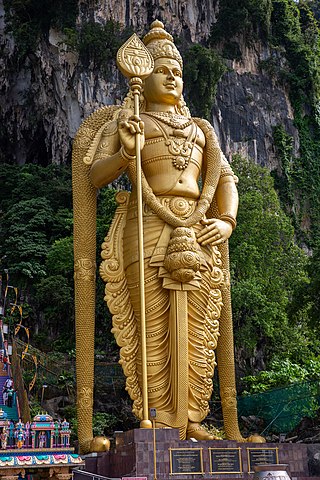
Kartikeya, also known as Skanda, Subrahmanya, Shanmukha and Murugan, is the Hindu god of war. He is generally described as the son of the deities Shiva and Parvati and the brother of Ganesha.
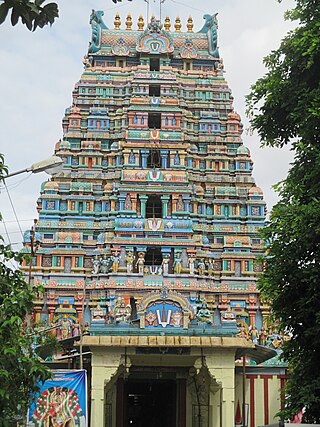
The Soundararajaperumal Temple is a temple dedicated to the Hindu god, Vishnu. It is located in Nagapattinam, a town in the South Indian state of Tamil Nadu. Constructed in Dravidian style of architecture, the temple is glorified in the Nalayira Divya Prabandham, the early medieval Tamil canon of the Alvar saints from the 6th–9th centuries CE. It is counted as one among the 108 Divya Desams dedicated to Vishnu. Vishnu is worshiped as Soundararaja Perumal and his consort Lakshmi as Soundaravalli.
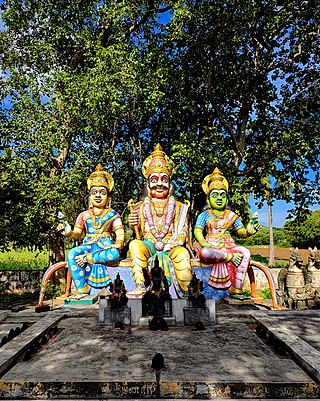
The early Dravidian religion constituted a non-Vedic, pre-Indo-Aryan, indigenous religion practiced by Dravidian peoples in the Indian subcontinent that they were either historically or are at present Āgamic. The Agamas are non-Vedic in origin, and have been dated either as post-Vedic texts, or as pre-Vedic compositions. The Agamas are a collection of Tamil and Sanskrit scriptures chiefly constituting the methods of temple construction and creation of murti, worship means of deities, philosophical doctrines, meditative practices, attainment of sixfold desires and four kinds of yoga. The worship of tutelary deities and sacred flora and fauna in Hinduism is also recognized as a survival of the pre-Vedic Dravidian religion. Dravidian linguistic influence on early Vedic religion is evident; many of these features are already present in the oldest known Indo-Aryan language, the language of the Rigveda, which also includes over a dozen words borrowed from Dravidian. The linguistic evidence for Dravidian impact grows increasingly strong as one moves from the Samhitas down through the later Vedic works and into the classical post-Vedic literature. This represents an early religious and cultural fusion or synthesis between ancient Dravidians and Indo-Aryans that went on to influence Indian civilisation.

Church of Our Lady of Presentation is a church of the Roman Catholic Diocese of Batticaloa in Thandavanveli. The church is one of a landmarks and catholic historical places in the district of Batticaloa, Sri Lanka. According to the recorded documents, it is known as the first and oldest church in the district.

Thirukkovil Temple is the most significant Hindu temple in Thirukkovil, Ampara District of Eastern Province, Sri Lanka. It is dedicated to Chitravelayudhar who was once the guardian deity of Mattakkalappu Desam and this temple enjoyed the honor of Desathukkovil of the Batticaloa region. Archaeological and historical evidences suggest that Cholan, Kotte and Kandyan kings maintained strong relations with this temple in the past.
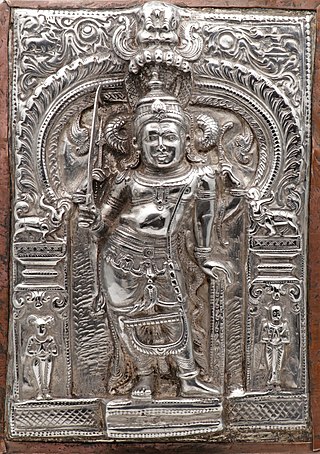
Vannar is a Tamil caste found primarily in the Indian state of Tamil Nadu and northeastern parts of Sri Lanka. The community has traditionally been involved in War. also agricultural workers They are in Tamil Nadu classified as Most Backward Class.

The Rajakulathor people, who are also collectively known as Rajaka, are native to the Tamil Nadu, Andhra Pradesh, Karnataka, India. They comprise the Vannar, Madivala and Agasa social groups that share a common myth of origin and claim to have once been members of various ancient South Indian dynasties.
Thurumbar is a Tamil caste found in northeastern part of Sri Lanka and the Indian state of Tamil Nadu. They are traditionally occupied in laundry, notedly performed in service for caste members from the lower strata. They are also known for their involvement as sorcerers.

Neelasothaiyan Commander-in-Chief of King Periyathambiran who ruled the city of Valavai,that he was born in the Vannar clan and conquered the Pandyas and conquered 6000 warriors in his army and ruled their country.


















